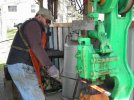Mike, I have some of the measurements. The drive pulley is 4" thick through the main shaft hole. The width of the surface of the drive pulley that the belt rides on is 2 and 7/8". The front shaft bushing is 5 and 3/8" long and 3" in diameter with a 1 and 7/8" hole for the shaft. The rear bushing is 5 and 1/4" long and 1 and 7/8" in diameter with a 1 and 3/8" hole for the shaft. The rear one is pretty thin. I haven't used a micrometer in years, but I believe the shim thickness is .045".
I am building a base for the hammer. I need to isolate it some, even though the floor in this shop seems really thick. I am planning on 3/4 plywood on bottom, 4x4 in the middle, 3/4 plywood on top and a layer of 5/8" rubber either on the floor or directly under the hammer. What do you guys think? Might be a little thick, but I am 6' tall, and wouldn't mind the hammer to be a little higher. How do you make the treadle work when you jack up the hammer?
Robert, it looks like, to me, to move the drive pulley to the rear, you need a new shaft at the same (- tolerance) of a reamed-to-round (or bored) (minimum 85% clean-up) front bushing hole. The rear bushing needs to come out, the rear yoke bored out, and a new rear bushing made that will interference fit in the new rear yoke hole. You should be able to have the new shaft stepped down where the end-mount drive pulley will go so the drive pully hole fits without modifying. These machines are precise but I still feel, having the ability, line boring/reaming both bushings off the same set up and while in place is the better road. Me, I'd be building a platform that carried the motor (and jackshaft, if needed) overheard, or for some other solution avoiding a rear mount drive pulley... but that's just me.
Many solve the problem of treadle-too-high-above-floor by throwing down a block tall enough that when the operating foot's heel is on it, the treadle can be reached. I've also seen "L" shaped additions to treadles... top of "L" hard to treadle, length of "L" upright moving base of "L" close enough to floor to rest operating foot heel on floor. The pan attached to your treadle changed the floor to treadle distance to some extent. I've also thought of mounting a pivoting ramp to the treadle where the treadle foot would most often be. If it easily pivoted on the treadle bar, with the other end ramped down to the floor and the floor end was able to slide (roll?) on the floor, a person could step on the ramp anywhere and move the treadle.
In the end, your machine needs to be rebuilt and running to figure out the linkage variables and how they effect a variable treadle height position. Until then, you won't know what the problem is (if there is one) you need to solve. An aspect of "rebuilt and running" is the hammer is very easy to regulate between very slow and very fast beats-per-minute... and that is a belt thing, in large part, and includes range of idler movement, belt stretch, belt sticktion... (how do you like that last word? May not have used it right but it's "real"... =] ).
A question I asked that got lost... does your machine have a treadle eccentric?... an about 3/4" thick and about 2 " diameter round with bolt hole offset near one edge of the 2" dia. flat? On Bruce's machine, which came with one, and on our machine, which did not, they are used to limit the treadle return height. I'm not sure they do not have a direct relationship to the return springs but I do know they have a direct relationship to the linkage setting, brake setting, counter weight setting. That is, you can't change any of those four things without effecting all of the others.
Mike




